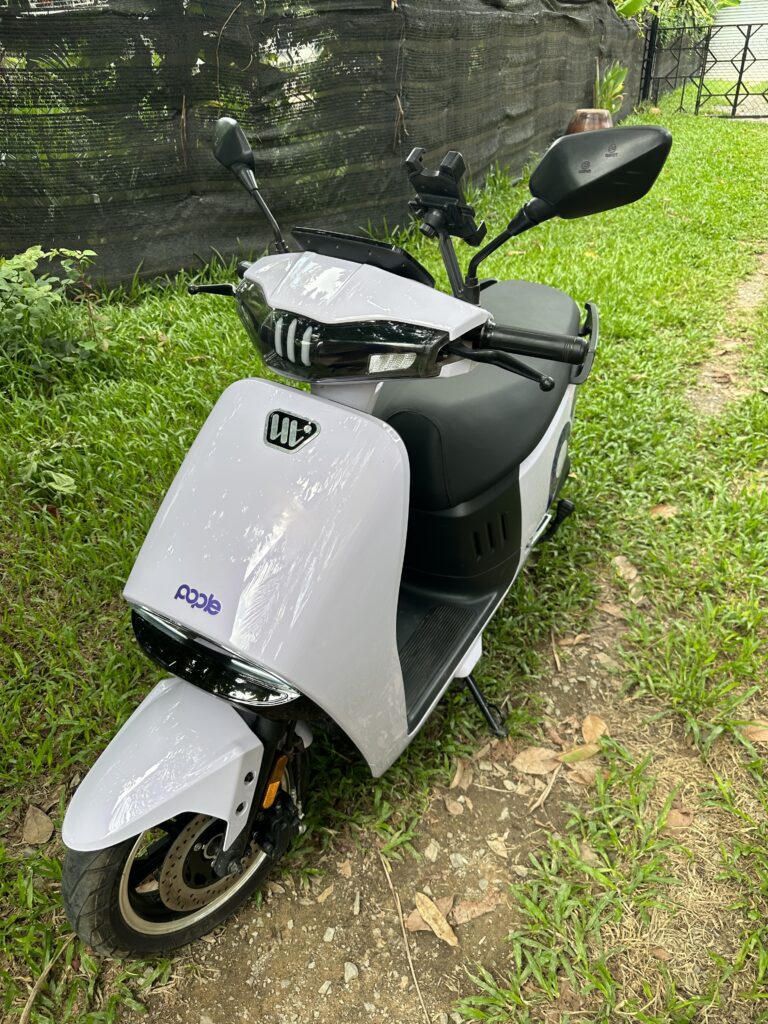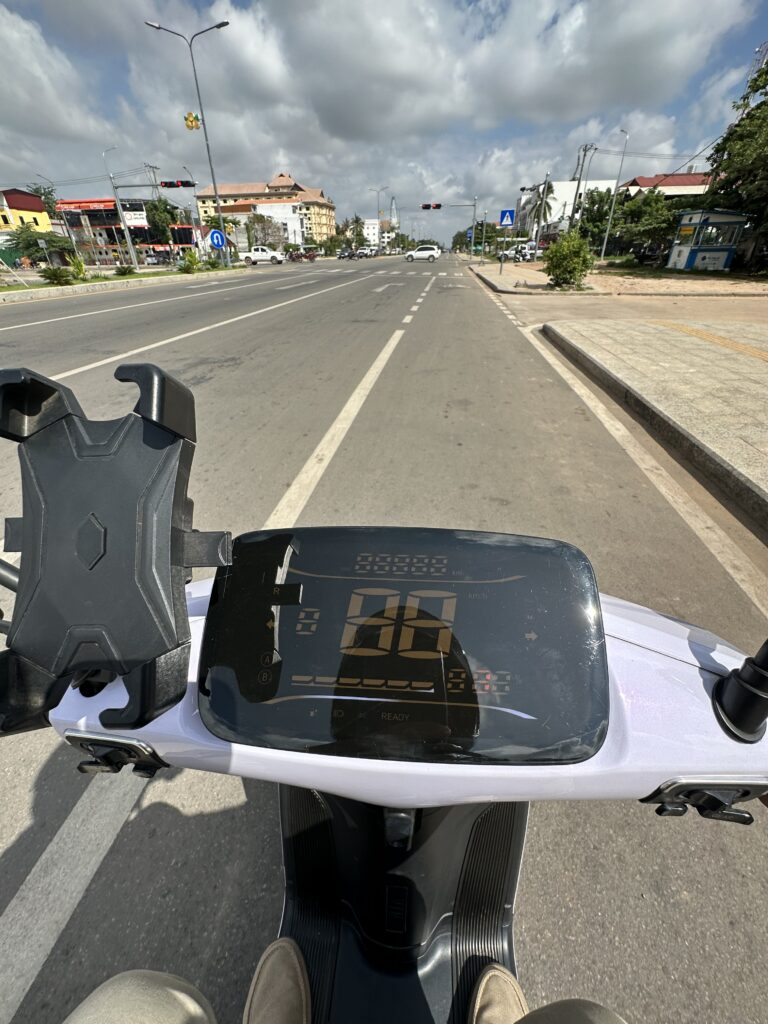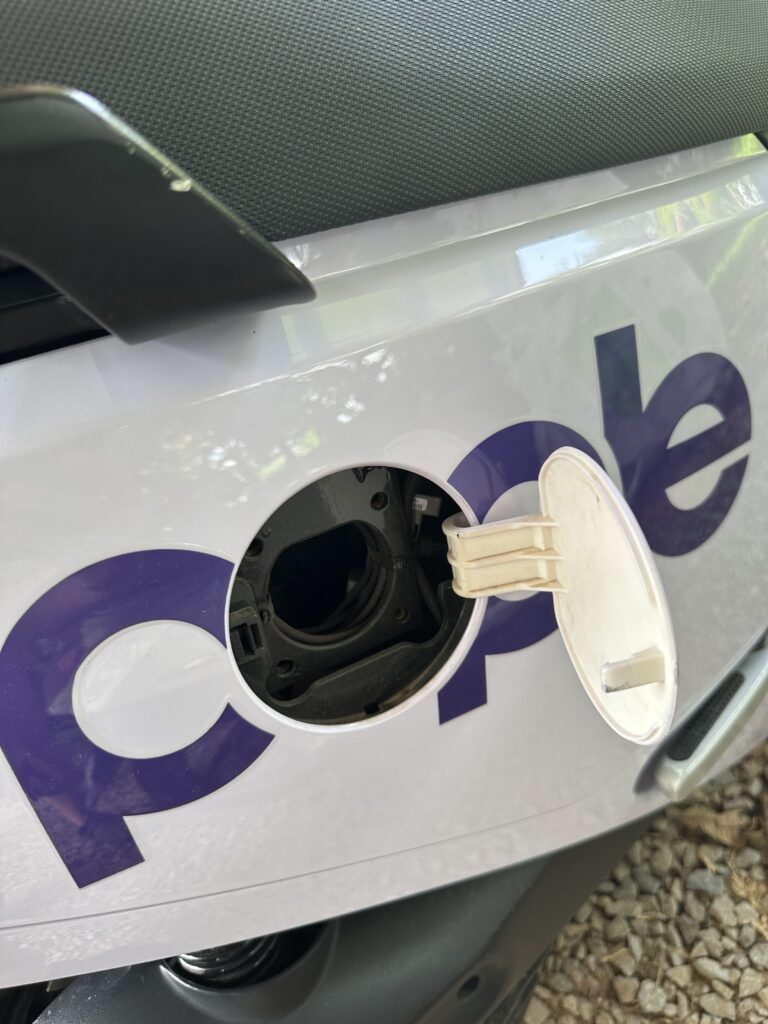After riding a Voltra Matrix electric scooter in Cambodia for 1,5 years now, I thought it might be time to check the competition. A company called Very Words made some noise recently with electric scooters named Pople. They have an agreement with Food Panda and recently opened what they call a factory in the Kandal province south of Phnom Penh. I thought it might be time to do a test ride with a Pople electric scooter from Very Words in Cambodia.

The scooters are for rent here in Siem Reap, for $15 a day – which is reasonable. The target market are tourists, and the rental shop is also a coffeeshop and a tour agent. They charge the batteries with solar panels on top of the building – a big plus.

The Pople / Very Words electric scooter
The scooter looks much more similar to the fuel powered ones than the Voltra Matrix. It feels like a solid built with bigger tires and a seat in a higher position. You can compare it to a Honda Click 125. It has a electronic key to start and a knob to turn in on and off after unlocked. Easy to handle. The stand cuts the power off, a security feature I like and know from Honda.
The acceleration is slower than with the Voltra Matrix, which is actually a plus. You still have a fast but smoother start. Once going you have three gears: 1 goes up to 35 km/h, 2 goes up to 50 km/h and 3 to 63 k/hm. In my test the top speed was slightly slower. That is an issue when using speed 1. The Voltra Matrix gives you 40 km/h (and after 20km 37 km/h), while the Pople made it just to 32 km/h. Feels to slow for a ride, in particular when you have to go straight for 10 km.
Speed 2 is decent, ob to 48 km/h in my test and fun to ride. This is the average speed setting for a normal day, but: The battery drained 20 % after just 16 km. The odometer resets and I forgot to note the overall km, but measured my ride on Google Earth. The Voltra Matrix gets to 20 km until the first bar goes off – about 20 % as well.
The battery model with Very Words
Very Words has a special battery model. You basically buy the scooter, but not the battery. Those are provided for free and fully charged at the Pople station. You cannot charge the battery at home (there is a home charger planned, but not yet available). One reason for the swap model is, that Very Words want to ensure the solar power is used for charging (but just 50 %). The other reason is that once there are more swapping stations its convenient for users. After my Matrix drained down to zero a few times I am skeptical – it means I always have to have enough juice left to go back to the station. The staff offered come and swap if there is a problem. They may build more stations in Phnom Penh and then Siem Reap as well.

Driving is smooth and a much better experience than the Voltra thanks to the bigger wheels and the frame. I could imagine to go for 100 km, if the battery would allow that. The seat is comfortable and also good for two people. As usual, weight and road conditions can impact the battery performance.
The Pople / Very words electric Scooter – I am still confused what the exact name is – comes with a 3000 W motor and two batteries 36 V 40 AH. Voltra has a 2000 W motor and 60V32AH batteries. While Voltra uses now Samsung batteries, Pople doesnt mention the manufacturer. The sales price is around $1600 – the company makes it a secret as they don’t mention it on Facebook. Their website is in Korean.
The company Very Words
Behind the Pople electric scooter in Cambodia is the Very Words company. From what I see it seems to be Korean owned. They opened a factory in Kandal, but the photos suggest that it is more a warehouse with parts and some space to assemble new bikes. I couldn’t see a assembly line. The Khmer Times said its a 2 Million USD investment and they plan 3000 unites per year. They also plan to export some models according to the news article.
The verdict: Should you buy the Pople Very Words electric scooter in Cambodia?
After a one day test ride I was impressed by the overall quality of the electric scooter. On the right side there is a still a fuel cap, so it seems to be a modified regular motobike. The staff told me the parts are made in China, the design is Korean and the bikes are assembled in Cambodia.
The Company is a bit shy when it comes to online marketing, as if they haven’t started sales yet. But they delivered the first batch of orders a few days ago – after a five month delay.

While I am happy with driving this electric scooter in Cambodia, my two concerns are battery performance and spare parts. The latter is just the usual suspicion against smaller companies – but it seems they do have some in stock. The battery is the bigger issue: My bike was a rental, the display said 2700 km, but not sure how old the battery was. As the motor is more powerful and you drive with higher speed, it drains faster and needs more recharge cycles. It shouldn’t be a concern, since you can just swap the batteries. But this can be inconvenient when you are at the other side of town – and the shop is open only 7am to 7pm.
Compared to the Voltra Matrix I think its a better scooter, while the battery issues seem to be the same. I do have the impression that there is more investment done than with Voltra, but there is still the risk that the company disappears in a few years and you are left with your bike. While you could improvise with the Voltra battery, it would be much more difficult with the Pople. So let’s just hope they are successful and stay for a long time. Or wait for a Honda e-scooter.

